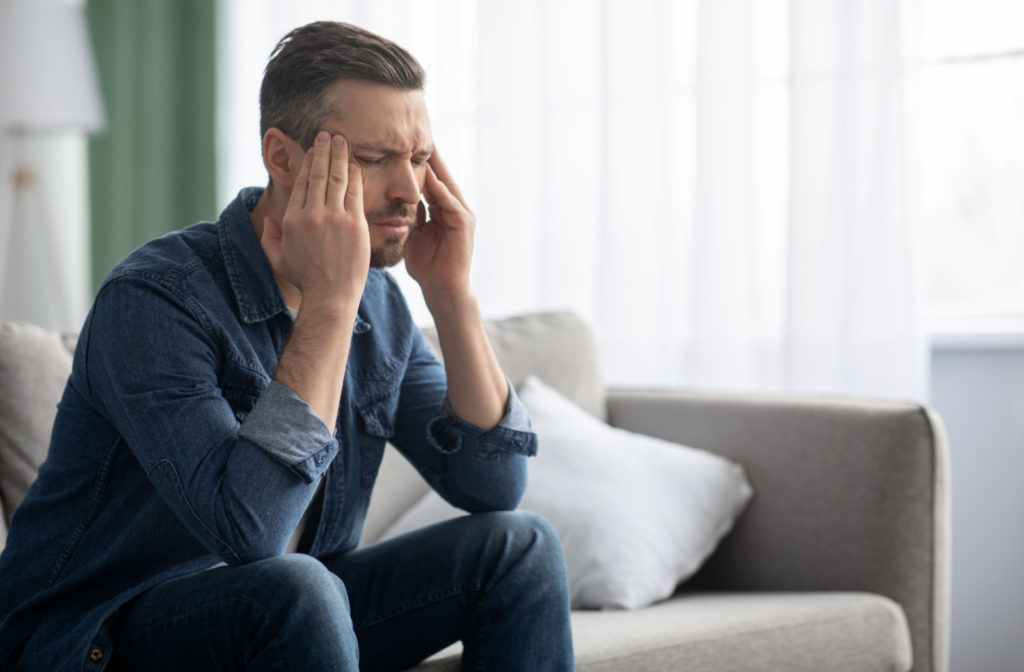You can experience a headache and have dry eye symptoms together. However, this doesn’t mean that your dry eye is causing your headaches.
Dry eye and headaches may have the same trigger or underlying cause. A comprehensive eye exam performed by your eye doctor can help determine why you’re more prone to experiencing dry eye and headaches at the same time.
What Is Dry Eye?
Imagine your eyes are like a well-oiled machine, providing a smooth eye surface and clear and comfortable vision. Now, imagine the oil is running low, leading to vision discomfort and mild to severe dry eye symptoms.
Dry eye or dry eye disease occurs when your eyes can’t produce quality tears or sufficient tears to keep them lubricated. The result? A dry and gritty feeling for most of the day if not addressed and treated.
What Causes Dry Eye?
Dry eye disease can affect anyone. From staring at screens for extended periods to environmental factors like dry air or windy weather, the causes are diverse. Other factors that can cause dry eye include:
- Aging: Tear production tends to decrease as we get older.
- Medications: Antihistamines, decongestants, and antidepressants can also contribute to dry eye.
- Medical conditions: Autoimmune diseases, arthritis, and even diabetes can reduce tear production.
- Gender: Hormonal changes in women during pregnancy and menopause can affect tears.
Dry eye Symptoms
Dry eyes don’t just stop at the occasional discomfort. You might experience redness, a burning sensation, and excessive tearing as your eyes attempt to compensate for the lack of moisture.
Other possible symptoms of dry eye can include:
- Blurred vision
- Sensitivity to light
- Eye pain
- Eye fatigue
- A stinging sensation
- A gritty feeling in the eyes
- Double vision
- Discomfort wearing contact lenses
- Stringy mucus in or around the eyes
- Eyelids sticking together in the morning
Does Dry Eye Cause Headaches?
While no evidence suggests dry eyes cause headaches, dry eyes and headaches may have common triggers. When you identify and address the trigger, you can find relief from dry eye and headaches.
Some studies have shown a link between dry eye and headaches. One study showed that people who have migraines or headaches of varying degrees have a 20% greater risk of a diagnosis of dry eye disease than individuals without migraine headaches.
The exact relationship between dry eye and migraines is unclear, but several links may play a significant role in both conditions. These can include:
- Eye strain: Digital eye strain caused by long periods in front of screens can lead to tired and dry eyes. If you experience eye strain, you may also feel neck pain and muscle tension from sitting in one position, leading to headaches.
- Cluster headaches: These are severe headaches affecting one side of the head. You can feel the pain from cluster headaches on one side of the head and behind the eye. Individuals may confuse eye pain with dry eyes.
- Sjörgen’s: Sjörgen’s syndrome is an autoimmune condition where the body attacks its own tissues. In Sjörgen’s, the immune system attacks the glands that produce tears, leading to dry eyes. The condition can also cause headaches.
Management & Treatment for Dry Eye
Your eye doctor will recommend a treatment plan for dry eyes based on the underlying cause.
Different Types of Eye Drops
First and foremost, artificial tears are your new best friends. These over-the-counter eye drops can provide the lubrication your eyes crave, helping to soothe dryness and minimize irritation. Oasis Tear Plus is a preservative-free product that can moisten your eyes.
If over-the-counter options don’t quite cut it, your eye doctor might recommend prescription eye drops. These drops can tackle inflammation and promote better tear production, giving your eyes the boost they need. Your eye doctor may prescribe a gel, such as Refresh Celluvisc, for moderate dry eye.

Lifestyle Adjustments
Beyond eye drops, lifestyle adjustments can also play a pivotal role. Remember to blink regularly, especially if you spend most of the day staring at screens.
Use the 20-20-20 rule to take breaks to rest your eyes. Every 20 minutes, look at something 20 feet away for 20 seconds. Using a humidifier to add moisture to the air can create a more eye-friendly environment.
Intense Pulsed Light Therapy
In some cases, like in meibomian gland dysfunction, your eye doctor might recommend a specialized treatment like intense pulsed light therapy (IPL). The light energy from IPL can warm blocked oil glands to improve tear flow and quality. The light can also target the blood vessels in the eye to reduce inflammation.
Dry Eye Therapy
Dry eye and headaches can affect eye health, vision, and quality of life. Even without clear evidence that headaches are caused by dry eye, there is a link. If you experience discomfort or vision changes, book an appointment with Family Focus Eyecare to determine the cause and receive treatment options such as dry eye therapy for symptom relief.
Think you might have symptoms of Dry Eye? Take a Free Dry Eye Assessment here.



